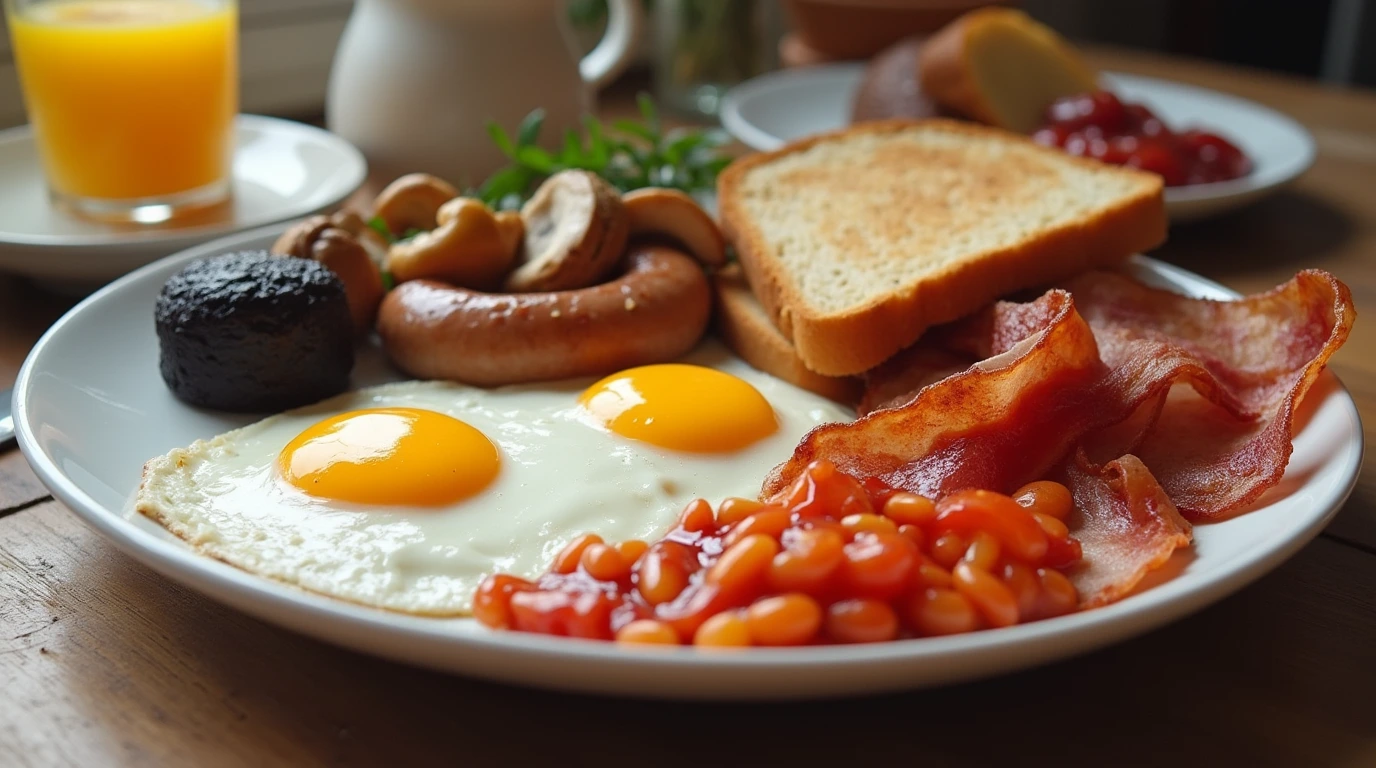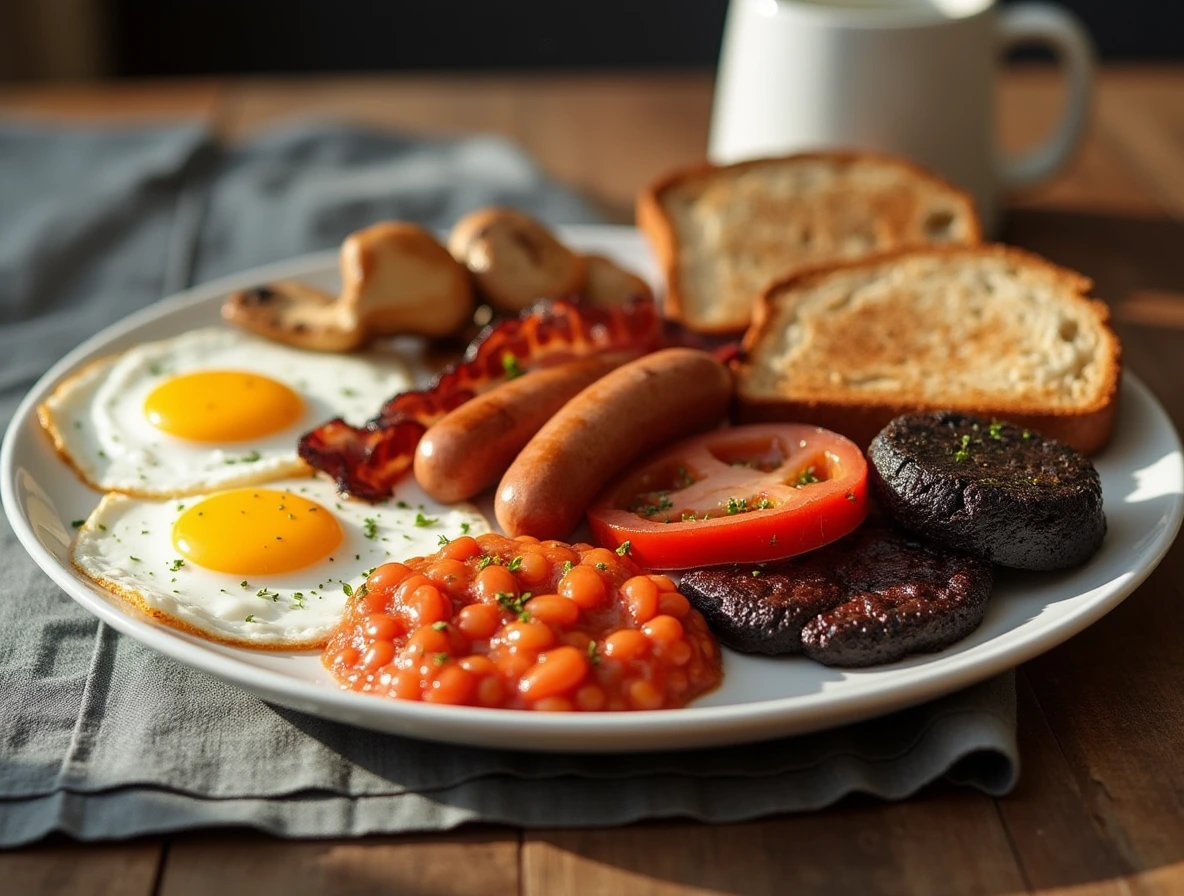The English breakfast, also known as a “Full English,” is a hearty, iconic meal that has been enjoyed for generations. With its variety of components and cultural significance, this traditional spread is a must-try for anyone seeking a true taste of British cuisine.
What Is an English Breakfast?
An English breakfast is more than just a meal—it’s an experience. A typical Full English breakfast includes a hearty selection of eggs, bacon, sausages, beans, black pudding, grilled tomatoes, fried mushrooms, and toast, all served hot and often accompanied by a cup of strong tea or coffee. This meal is perfect for fueling your day, offering a satisfying and energy-packed start, or savoring as a weekend treat when time allows for a leisurely breakfast.
The roots of the Full English breakfast can be traced back to the Victorian era, when it was seen as a symbol of hospitality and affluence. The meal was initially enjoyed by the wealthy elite and often served in large, indulgent portions. Over time, the Full English breakfast became a comforting staple for people of all social classes, becoming a defining feature of British culture. It became a popular choice in hotels and inns, where it was traditionally offered as the main meal of the day.
The Full English breakfast varies slightly from region to region, with some areas adding specific ingredients like fried bread or bubble and squeak (a mix of leftover vegetables). Regardless of the variations, the key to this breakfast is its filling nature and its ability to keep you satisfied for hours. For a modern, yet equally delicious variation, try a sausage breakfast casserole. This dish incorporates many of the traditional elements in a new, flavorful way, making it a perfect addition to any breakfast spread. Whether you’re at home or visiting a British cafe, an English breakfast is the ultimate comfort food.
Components of a Traditional English Breakfast
A classic English breakfast is famous for its variety, heartiness, and perfect balance of flavors. It combines a range of ingredients that, together, create a filling and satisfying meal. Here’s a closer look at the essential components:
Eggs
Eggs are the centerpiece of a Full English breakfast. People often serve them fried (sunny side up or over-easy), scrambled for a creamy texture, or poached for a delicate, runny yolk. Regardless of the preparation, eggs add richness and protein, tying the meal together.
Bacon
Back bacon is the preferred choice for a traditional English breakfast. It’s thicker and leaner than streaky bacon, providing a meaty, savory flavor with just the right amount of crispness. Some people enjoy streaky bacon for extra crunch, though back bacon remains the classic option.
Sausages
Juicy pork sausages are a must-have. These sausages are usually flavored with herbs and spices, offering a savory bite that complements the other ingredients. They provide protein and flavor, adding depth to the meal.
Mushrooms
Grilled or sautéed mushrooms offer an earthy, savory element to the plate. Cooked in butter or oil, they become tender and absorb all the flavors around them. Mushrooms provide a nice contrast to the richer, meatier ingredients.
Tomatoes
Grilled or roasted tomatoes bring a tangy kick to the breakfast. Their natural sweetness shines through as they cook, and the slight char adds a smoky flavor. Tomatoes offer freshness that balances the richness of the other components.
Baked Beans
Baked beans in a tomato-based sauce add a sweet and tangy contrast to the savory items on the plate. They provide a comforting texture and bring an unexpected flavor that ties everything together.
Toast or Bread
You can’t forget the toast. Typically buttered, it serves as the perfect vehicle for mopping up any leftover egg yolk or sauce. People often pair it with jam or marmalade for a touch of sweetness, which balances the savory flavors of the meal.
Black Pudding
For the more adventurous eaters, black pudding (a type of blood sausage) offers authenticity. With its rich, savory, and slightly spicy flavor, it adds a distinctive element to the breakfast. While optional, it’s a beloved part of the traditional Full English for those who enjoy it.
A Full English breakfast combines all these ingredients into one hearty meal, ensuring that you feel full and satisfied. Whether enjoyed on a weekend morning or as a special treat, this dish is an iconic part of British culinary culture.
Looking for another hearty option? Try a chicken and rice recipe, which offers a satisfying alternative while still delivering a fulfilling, protein-packed meal. While it’s not a traditional English breakfast, it provides a similar sense of comfort and satisfaction.
How to Make a British morning meal at Home
Creating an authentic English breakfast at home is easier than you might think.
Step-by-Step Recipe
- Cook the Meats: Start by frying sausages, bacon, and black pudding.
- Prepare Vegetables: Grill tomatoes and mushrooms for added flavor.
- Eggs Your Way: Fry, scramble, or poach the eggs.
- Heat the Beans: Warm baked beans gently in a saucepan.
- Toast the Bread: Serve buttered or with marmalade.
- Assemble and Serve: Plate everything while still hot and serve with tea or coffee.
For a quicker yet equally delightful breakfast, check out these easy bake oven recipes for inspiration.
Tips for a Healthier Breakfast
While a traditional English breakfast is hearty, you can make healthier choices:
- Substitute turkey bacon or plant-based sausages.
- Use whole-grain bread instead of white toast.
- Grill instead of frying to reduce fat content.
Pairing your breakfast with fiber-rich sides like a pumpkin banana loaf can also add a nutritious twist.

FAQ
Why is it called a “Full” English Breakfast?
The term “full” reflects the meal’s completeness, featuring multiple hearty components for a satisfying start to the day.
Is the Full Breakfast healthy?
While delicious, the traditional version is calorie-dense. Opting for grilled components and healthier substitutions can make it more balanced.
Can I make a vegetarian English breakfast?
Yes! Replace meat with vegetarian sausages, grilled halloumi, or even avocado for a modern twist.
Nutritional Value of a Traditional English Breakfast
To provide a more accurate estimation of the nutritional value of a traditional Full English breakfast, let’s break down the quantities of each component and their approximate nutritional content. The following values are for a typical serving of a Full English breakfast, which might consist of:
- 2 eggs (fried or scrambled)
- 2 slices of back bacon
- 2 sausages (pork)
- 1/2 cup of grilled mushrooms
- 1 grilled tomato
- 1/2 cup of baked beans
- 1-2 slices of buttered toast
- 1 slice of black pudding
Nutritional Breakdown (Approximate)
| Component | Quantity | Calories (kcal) | Protein (g) | Fat (g) | Carbohydrates (g) | Fiber (g) | Sodium (mg) | Vitamins/Minerals |
|---|---|---|---|---|---|---|---|---|
| Eggs | 2 large eggs | 140 | 12 | 10 | 1 | 0 | 140 | High in protein, vitamin B12, vitamin D |
| Back Bacon | 2 slices (60g) | 180 | 12 | 14 | 0 | 0 | 600 | Iron, zinc, B vitamins, high in saturated fat |
| Pork Sausages | 2 sausages (150g) | 300 | 18 | 24 | 2 | 0 | 700 | Protein, B vitamins, iron |
| Mushrooms | 1/2 cup (70g) | 15 | 2 | 0.2 | 3 | 1.5 | 1 | Potassium, selenium, antioxidants |
| Tomato | 1 medium tomato | 25 | 1 | 0.2 | 6 | 1.5 | 5 | Vitamin C, lycopene, potassium |
| Baked Beans | 1/2 cup (130g) | 125 | 6 | 1 | 27 | 6 | 500 | Fiber, iron, protein, folate |
| Toast (whole grain) | 2 slices (50g) | 140 | 5 | 3 | 24 | 4 | 200 | Fiber, B vitamins |
| Black Pudding | 1 slice (50g) | 160 | 10 | 12 | 1 | 0 | 500 | Protein, iron, zinc, high in fat and cholesterol |
Total Nutritional Value (Approximate)
| Total | | 1,085 kcal | 64 g | 64.4 g | 62 g | 13 g | 3,645 mg | High in protein, healthy fats, fiber, iron, B vitamins, antioxidants |
Nutritional Insights:
- Calories: A Full English breakfast is quite calorie-dense, with around 1,085 kcal. This makes it a substantial meal that provides a large portion of the daily energy requirement, especially for those with active lifestyles.
- Protein: The meal offers 64 g of protein, which is great for muscle repair and overall bodily functions. This comes from eggs, sausages, bacon, and baked beans.
- Fat: At 64.4 g of fat, it’s a meal that contains a significant amount of saturated fat, particularly from the bacon, sausages, and black pudding. While fat is an essential nutrient, moderation is key.
- Carbohydrates: With 62 g of carbs, mainly from the toast and baked beans, this meal provides a good source of energy. However, the carb content can vary depending on bread type (e.g., whole grain vs. white bread).
- Fiber: With 13 g of fiber, the breakfast provides a decent amount of fiber, largely from the vegetables, beans, and whole-grain toast, which supports digestion and satiety.
- Sodium: At 3,645 mg of sodium, this meal is quite high in salt, largely due to the processed meats and baked beans. It’s important to be mindful of sodium intake, especially for those with hypertension or heart-related conditions.
Vitamins and Minerals:
- The breakfast offers a good amount of B vitamins (from eggs, bacon, and sausages), which help with energy production.
- Vitamin C from the tomatoes helps with immune function and skin health.
- Iron is provided by the black pudding, bacon, and sausages, which is important for blood health.
- Potassium, which supports heart health and muscle function, is found in mushrooms, tomatoes, and beans.
Conclusion
While a Full English breakfast is undeniably rich in essential nutrients, it is also quite high in calories, fats, and sodium. With components like bacon, sausages, and black pudding, the meal provides a hefty dose of protein, iron, and vitamins. However, due to its significant calorie count and the presence of saturated fats and salt, it’s best enjoyed in moderation, especially for individuals looking to manage their weight, cholesterol, or sodium intake. For those concerned about heart health or blood pressure, it might be beneficial to make occasional adjustments, such as opting for leaner cuts of meat or replacing some of the fried elements with grilled or poached alternatives.
Moreover, to maintain a balanced diet, it’s advisable to pair the Full English with lighter meals throughout the day. For instance, following it with a fresh salad or a smoothie can help ensure that you’re getting a variety of nutrients, including more fiber, vitamins, and antioxidants, which balance out the richness of the breakfast. Additionally, it’s important to stay mindful of portion sizes; enjoying a smaller portion of the Full English allows you to experience its flavors without overindulging.
Beyond its nutritional profile, the English breakfast is a cultural icon. Its roots in British history, particularly during the Victorian era, give it a sense of tradition that has stood the test of time. The Full English breakfast is beloved not only for its variety but also for its hearty ingredients and versatility. It can easily be customized to suit personal preferences, making it both a comforting and adaptable meal. Ultimately, whether you stick to the traditional recipe or add your own spin, the Full English breakfast guarantees a memorable morning, setting the tone for a fulfilling day ahead.
